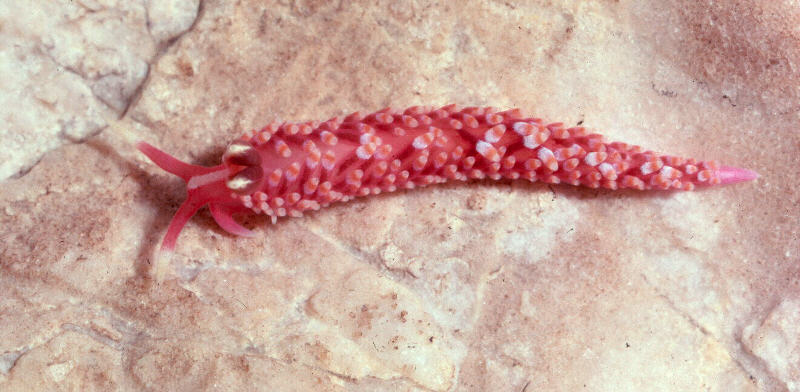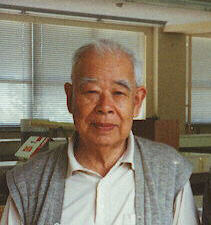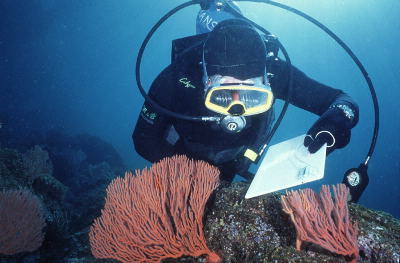 |
Babakina festiva
In Memoriam

|
I was especially saddened by the death of a remarkable gentleman, Dr. Kikutaro Baba, on 30 November 2001. Like so many other opisthobranch researchers from the United States and elsewhere, I never had the honor of meeting him. However, I did have a lengthy correspondence with him during the course of almost 30 years. Many letters he sent were in the special "fold-over" air mail envelopes, inside of which were his carefully typed message and his precise signature. He was always extremely respectful, kindly, and willing to share his knowledge and both published and unpublished research efforts. He is missed, and we thank him for having given us so much.
In 1993 I published an article entitled, "Japanese Contributions to Opisthobranch Research, with special Reference to Takeo Abe, Iwao Hamatani, and Kikutaro Baba.." That articles includes a brief biography of each, and a list of all their publications to the middle of 1992. Following are quotations from portions of that article regarding the life of Dr. Baba, and the significance of his research: "Dr. Kikutaro Baba has almost single-handedly described the biodiversity of the Japanese opisthobranch fauna. A measure of the esteem in which he is held is shown by the patronyms he holds: 3 genera (Babaina Odhner, 1968, Babakina Roller, 1973, and Babiella Risso-Dominguez, 1964) and 8 species of opisthobranchs have been named for him (Linguella babai Tchang-Si, 1934, Marionopsis babai Odhner, 1936, Elysia babai Pruvot-Fol, 1945, Okenia babai Hamatani, 1961, Tamanovalva babai Burn, 1965, Flabellina babai Schmekel, 1970, Cyerce kikutarobabai Hamatani, 1976, Chelidonura babai Gosliner, 1988)." |
"Dr. Baba has published segments in 19 books in Japanese, more than 50 miscellaneous notes and papers in Japanese, 55 articles in the Japanese aquarist magazine Collecting and Breeding, and more than 120 papers in English. Clearly his contributions to opisthobranch studies are monumental. Comparisons of the significance of his research must be made with Ludwig S.R. Bergh and Ernst and Eveline Marcus. However, whereas these researchers emphasized shapeless and colorless preserved specimens, Dr. Baba has always studied living specimens before dissecting their internal anatomical structure. This is essential to understand the morphological variation and anatomical characteristics of opisthobranch molluscs."
"Kikutaro Baba was born 11 July 1905 in Fukuoka Prefecture, Kyushi, Japan. In 1932 he was graduated from the Biology Department of the Tokyo Bunrika University. In 1940 he earned the degree of Rigaku-Hakushi (Dr. Sci.) from the Kyoto Imperial University. His dissertation was on the mechanisms of absorption and excretion in the solenogaster Epimenia verrucosa (Nierstrasz). From 1941 to 1943 he was a member of the Research Institute for Natural Resources attached to the Education Ministry, and from 1943 to 1947 he served as Military Government Professor of Zoology in the Jakarta Medical College, Java. He was a member of the Science Education Office, at Osaka Prefecture, from 1947-1948, and Professor of Biology in the Osaka First Normal School (1948-1949). Dr. Baba held the position of Professor of Biology at Osaka Kyoiku University from 1949 to 1971, and is now Professor Emeritus."
"In 1976 he received the Third Class of Merit of the name of His Majesty the Emperor of Japan. He bacame an honorary member of the Japanese Society of Systematic Zoology in 1987, and the Malacological Society of Japan in 1988. It is my extreme pleasure to report that he was named an honorary member of the Western Society of Malacologists in 1992."
While preparing my bio-bibliographical article, I asked for photographs of himself; he wrote me: "This is to respond to your requests just received. Of late years I have been mostly in my home to conclude my past studies, so I could not give you my latest pictures in the field.. Only a few pictures are enclosed here. My wife, Mrs. Sonoko Baba, is well, and helps me in various ways."
These pictures (some of which were published in my 1993 article in the Annual Report of the Western Society of Malacologists) are attached here.
(Personal Photographs Courtesy of Dr. Kikutaro Baba)
Picture 1 : Dr. K. Baba and Dr. Y. J. Hirano, in the laboratory of the Mukaishima Marine Biological Station, Seto Inland Sea, Japan; 20 April 1989.
Picture 2 : Dr. K. Baba, collecting at the Seto Insland Sea; 20 April 1989.
Picture 3 : Dr. K. Baba in his library at home; 20 July 1990.
Picture 4 : Dr. Kikutaro Baba at the microscope in his Shigigaoka Hill Room; 26 April 1992.
Picture 5 : Closer view of Dr. Baba at the microscope in his Shigigaoka Hill Room; 26 April 1992.
Picture 6: Dr. Baba at the Mt. Shigi-san Temple Yard; cherry blossoms in the background; 4 April 1992.
Picture 7 : Dr. Kikutaro Baba and Mrs. Sonoko Baba in front of their home; 10 October 1985.
This week's NUDIBRANCH OF THE WEEK, in honor of Dr. Baba, is the gorgeous eolid, Babakina festiva.
Originally named Babaina festiva , Dick Roller had to establish a second genus for this species, because his first proposed name was already preoccupied by Odhner's genus name. In the same paper where he originally described Babaina festiva, he also named the genus Emarcusia, in honor of Dr. Ernst Marcus. Most appropriate! Dick Roller later proposed Babakina as a substitute name for his occupied taxon.
The species is known from southern California to Nayarit, Mexico. It was also reported to occur in Japan. Roller wrote, "Eight specimens of what appear to be the same species have been collected from a 400 km long area of the west coast of Honshu Island, Japan, from 1956 to 1964 (Dr. Kikutaro Baba, personal communication)."
Curiously, the rhinophores originate from a single stalk for the basal 1/3 of their length; they are joined by a web of skin in the middle 1/3, and then separate into bulbous clavi. The bottom half is pinkish (same as the body color), and the distal portions are yellowish. The eyes occur within the lower ½ of the common stalk. The body color is pinkish-red; there is a broad swath of white on the head. Cerata are pinkish-red, with a central white band, tipped with yellow. The genital pore is ventral to the dorso-lateral ridge, just below the fourth row of cerata in the anterior liver.
Dr. Hans Bertsch
Imperial Beach, Calif
Jan. 2002
Bertsch, Hans. 1993. Japanese contributions to opisthobranch research, with special reference to Takeo Abe, Iwao Hamatani, and Kikutaro Baba. Annual Report, Western Society of Malacologists 25: 15-24.
Roller, Richard A. 1972. Three new species of eolid nudibranchs from the west coast of North America. The Veliger 14 (4): 416-423.
Roller, Richard A. 1973. Babakina, new name for Babaina Roller, 1972, preoccupied. The Veliger 16 (1): 117-118.
Underwater photo of Hans at Bahía de los Angeles

|
192 Imperial Beach Blvd. #A |
